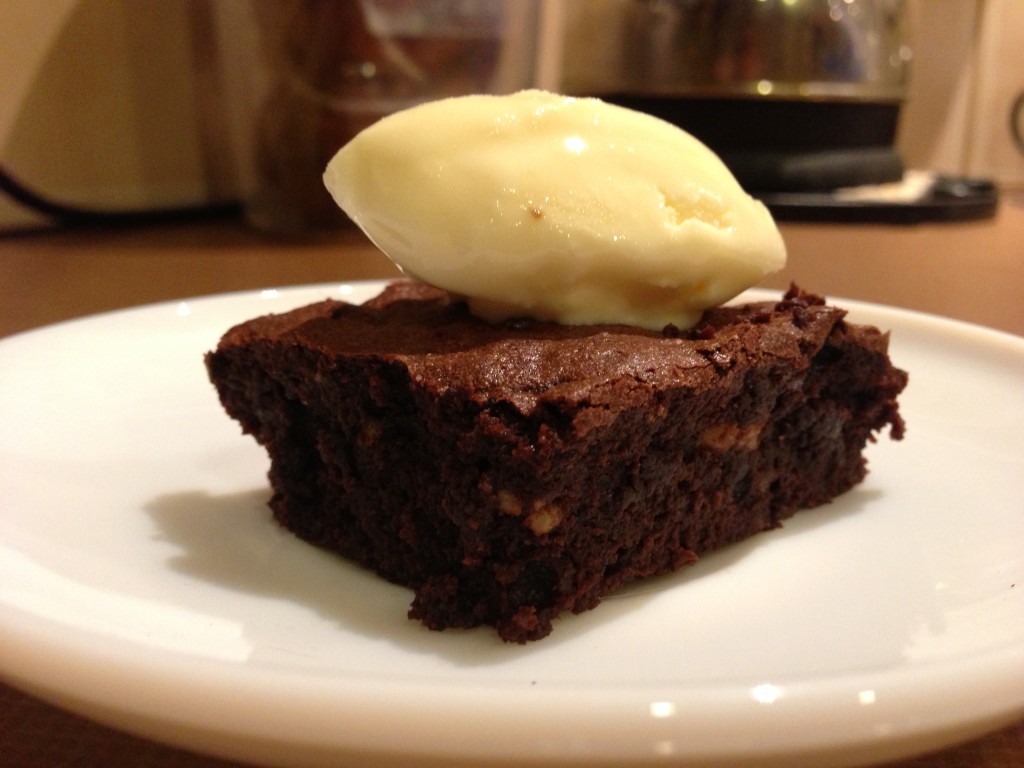
Low’ish fat brownie with quenelle of vanilla ice-cream (which probably just adds back the fat that I removed by cutting the butter content)
I was at home today working on my honours project, reading about solid agglomeration and deposition in liquified natural gas production (boring!) in the Journal of Cryogenics. It didn’t take long for me to become sidetracked, and before I knew it, I found myself browsing the Journal of Food Science (not unlike when you are on Youtube and somehow manage to navigate from an ordinary music video to a clip of a cat barking like a dog). Anyway, I ended up in the Journal of the American Dietetic Association and stumbled across an interesting research article titled Pureed Cannellini Beans Can Be Substituted for Shortening in Brownies written by Szafranski et al. (2005)*. Basically, the researchers noted that pureed cannellini beans could be used to replace the fat component of some cakes and biscuits without noticeable altering the perceived texture and taste. They tested the limits and found that in a particular brownie recipe, they could replace 50% of the shortening with cannellini beans before it became noticeable.
This study determined the overall acceptability, sensory characteristics, and nutrient content of brownies (bar cookies) made using cannellini beans as a replacement for shortening…This study demonstrated that pureed cannellini beans can replace as much as 50% of the fat (by weight) in brownies and yield and acceptable product.
It certainly was more interesting than reading about thermodynamics of natural gas, so off I went to the kitchen to test this for myself. The original research paper presents the exact recipe used, however it was lacking actual chocolate (using only cocoa powder), so I decided to use a different recipe and just replace 50% of the fat with beans. My recipe was as follows:
Ingredients
- 90g unsalted butter
- Pinch of salt
- 90g cannellini beans (drained and rinsed)
- 200g dark chocolate (70% cocoa solids)
- 85g plain flour
- 40g cocoa powder
- 50g coarsely chopped walnuts
- 3 eggs
- 270g castor sugar
Preparation
- Preheat an oven to 180°C (160°C fan forced)
- Break chocolate into small pieces and add it to a bowl with the butter. Melt the chocolate in a glass bowl over a pot of simmering water, or in a microwave. Mix until it forms a smooth mixture and let it cool to room temperature.
- Add the cannellini beans to a food processor and mix until a smooth paste is formed. Add a small amount of oil or water if the beans are too dry. Stir the bean puree into the melted chocolate and butter mixture and add a pinch of salt.
- In another bowl, beat the eggs and sugar vigorously for a few minutes until they have become aerated and about doubled in volume. It can be done with a whisk, but it will be much easier with an electric mixer.
- Fold the cooled chocolate and bean mixture into the eggs, being careful not to over-beat them. The chocolate and eggs should be well combined, but should remain light and aerated.
- Sift the flour and cocoa powder into the wet mixture, followed by the chopped walnuts. Again, carefully fold until everything is well combined into a uniform mixture.
- Carefully spoon the mixture into a shallow baking tin (about 20cm x 20cm x 2cm should be sufficient). Tap the tin on the bench to spread the mixture evenly. Bake it in the pre-heated oven for about 20-25 minutes, or until the brownie is firm but only just slightly set in the centre.
I have to say, it tasted pretty good! I would never have guessed in a million years that there were cannellini beans in it. Using beans as a fat replacement does add an extra step to the usual brownie-making process, but for the health conscious person who likes a regular brownie-fix it could cut hundreds of calories and masses of artery-clogging fat in the long run. The research article doesn’t test other baked goods, however it suggests that replacing the fat with pureed beans may be more noticeable in less moist products such as biscuits. It certainly does put a new twist on the concept of baked beans!
* The original research article can be accessed in The Journal of the American Dietetic Association (Volume 105, Issue 8, August 2005, Pages 1295–1298)
Interesting! I’m definitely going to have to try making these
Send some my way 😉 They’re great with ice-cream, especially since they are so rich with the 70% chocolate
Yes ice cream will be essential, followed by a generous serving of freestyle, breaststroke and backstroke at the pools 🙂